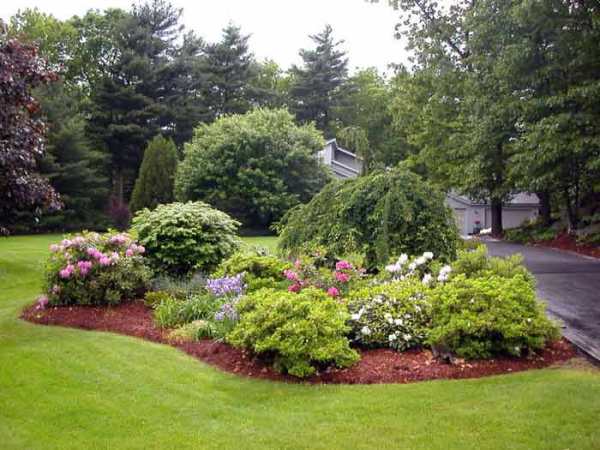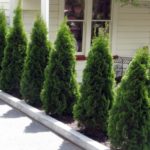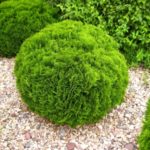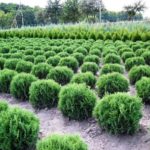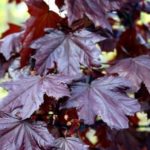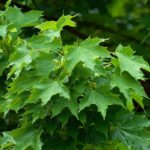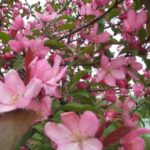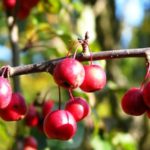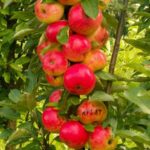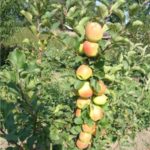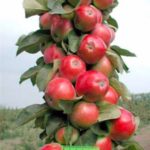The gardens and villas of the new wave are stylish cottages with a comfortable platform for the rest of the townspeople, surrounded by a beautiful landscape. The traditional cottage, the main function of which is to harvest, also necessarily includes a recreation area.lovingly decorated by the hosts. It is for the spectacular design of the backyard territory, the beautiful lawn, the playground for the children, that ornamental plants and trees are needed, which are worth discussing in detail.
Table of contents
The role of ornamental shrubs and trees in the modern garden
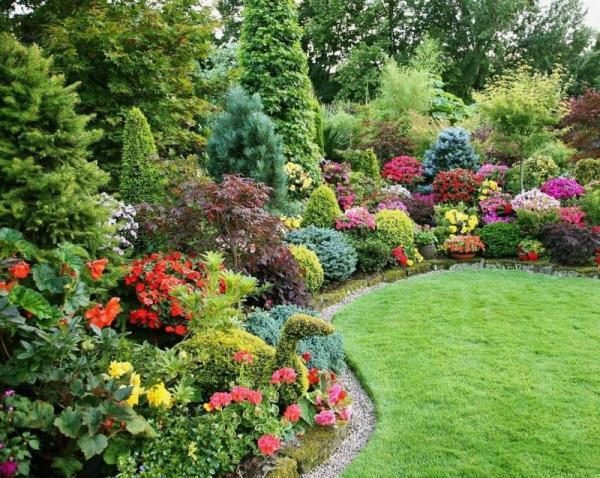
In addition to the natural aesthetic function - give a person enjoy the beauty of nature, ornamental trees and shrubs are used by gardeners and designers to solve purely practical problems. The visual expansion is too narrow, or a very small area. Decoration of outbuildings, strengthening of sloping areas and talus. Zoning of the site, the creation of dividing screens between the garden and the backyard zone. Protection of the individual space of a small cottage from prying eyes, without erecting a fence.
Popular ornamental trees in the garden and in the country
The current trend in gardening is a beautiful, fruit-bearing garden that does not require huge physical expenditures for the care and maintenance of decoration. The priority is the beauty and simplicity of trees; the practical use of plantations goes into the background. This explains the popularity of new forms of fruit and forest trees represented by modern breeding.:
- compact standard trees with spherical crown;
- dwarf forms fruit and forest trees;
- weeping forms;
- columnar hybrids habitual trees.
An interesting novelty is the use of forest trees to decorate a summer cottage. For example, hornbeam seedlings are sold by nurseries at bargain prices. The hornbeam is great for creating hedges, decorative backdrops and walls.
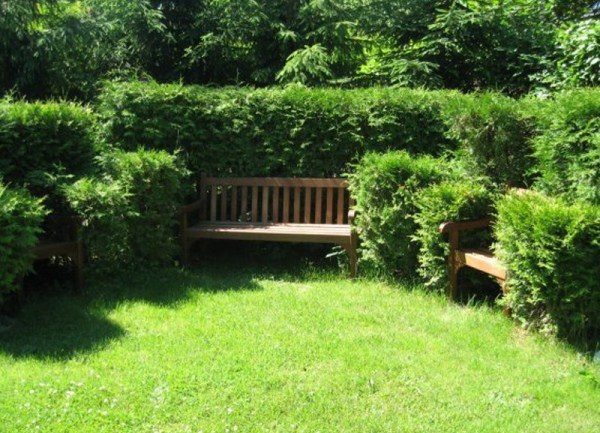
To create spectacular compositions, edging lawns, use trees of different heights.:
- tall (up to 6 m);
- medium tall (up to 3 m);
- stunted and dwarf trees (up to 1.5 m).
The backdrop is made of tall trees (wall, or focal point), which is complemented by lower trees and shrubs. The foreground of the composition is formed from undersized ones.Trees can be decorated with gravel dumping, placed on an open lawn, soloed, or combined into relief, multi-tiered groups.
The highest ones are planted in the background, then the middle ones. Stunted trees and shrubs have in front.
Recognized leader - conifer trees
Mature plants require little maintenance. Coniferous plants are decorative all year round, including the winter period. In early spring, many species bloom with bright lilac candles that resemble Christmas decorations.. Then comes the time of active growth, the young shoots are much brighter than last year’s branches. During this period, all coniferous trees look especially elegant.
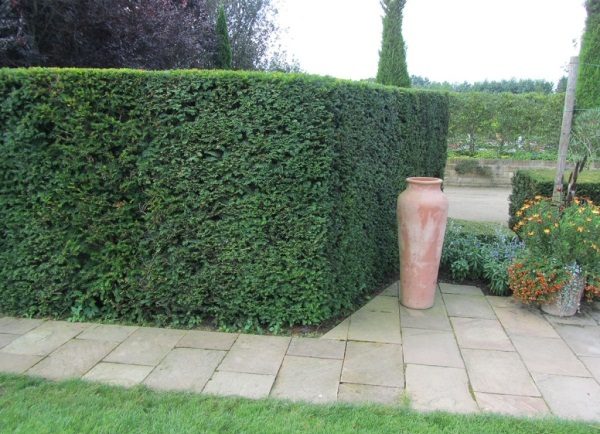
Spruce grows well in marshy soils, this is especially important for the Moscow region. Pine is drought-resistant, well tolerated pruning, which allows you to vary the height and decorative shape. For low hedges, walls can be recommended yew. Tees perfectly keeps its shape, does not require significant trimming.
Thuy
Unpretentious thuyu can safely choose as the main decorative element of the garden, which will combine planting a single plan. Thuis of different varieties will perfectly fit into the composition with low-growing shrubs, variegated and flowering trees.
In the nursery, you can pick up varieties of pyramidal, ellipsoid, or spherical shape. The garden wall of thuja planted with a smooth line looks very interesting. This allows you to unusually beat even the standard summer cottage.
- Pyramidal thuja
- Ball thuja
- Ball thuja
For the middle band recommended varieties and hybrids of Western thuja. Unpretentious grade Brabant suitable for the formation of the wall, backstage. A single thuja grows wide, a close landing of a thuja (after 0.5 m) will form a wall too low. The optimal distance between seedlings of the Brabant variety is 1 m. An interesting variety is Wagner's thuja, which has a rounded shape, shorter growth. Thuja loves the shower, spraying, sprinkling.
Decorative Maples
The most popular maple Canadian, Platanovidny, Nervotny maple with burgundy foliage. They are excellent solo in the open lawn, good in compositions and against the background of hedges.
- Maple canadian
- Norway Maple or Platinum-shaped maroon
- Maple Platanovid
Like most plants with brightly colored leaves, decorative colored maples prefer a sunny place. In the shade, the natural color will be faded. Maple prefers fertile soil with neutral acidity. Young seedlings should be sheltered for the winter. The adult plant of a frost-resistant grade will not demand it any more.
Exotic for lovers
Magnolia
It can be formed as a bush, but it can grow a full-fledged tree with a picturesque crown. Flowering magnolia is an exotic sight, most varieties have a delicate, vanilla - citrus scent.. Magnolia is covered with large flowers (bud length up to 12-15 cm). The color scheme and the shape of the flower revealed in different varieties of magnolia is very different.
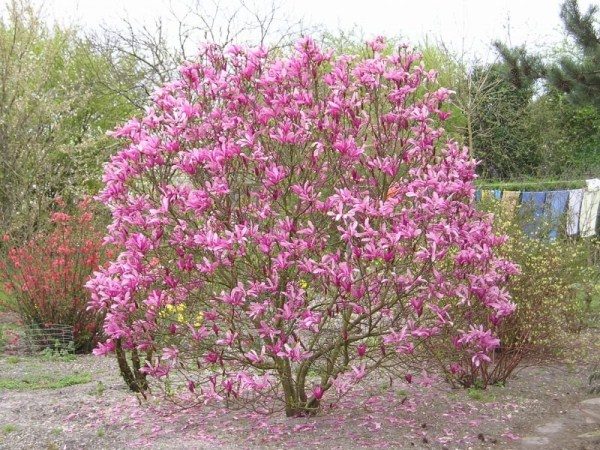
The capriciousness of magnolia is greatly exaggerated, for successful cultivation it is enough to follow a few rules. When planting magnolia special attention should be paid to the root system and the choice of landing site. It is necessary to buy magnolia with a basal lump (in a plastic container), preferably in a nursery or garden center. When planting try not to injure the roots of the seedling. Magnolia loves the bright sun, does not tolerate drafts and winds. The optimum landing place is under the southern wall of the house, any household building. He does not like calcareous soils, therefore such lands must be acidified with peat. Care of an adult plant is not needed, only minimal sanitary pruning. For growing in the gardens of the middle band, deciduous forms of magnolia and corresponding hybrids are recommended.
Sakura
A Japanese relative of a familiar cherry, famous throughout the world for its magical flowering. The growing conditions for sakura and magnolia are identical. Sunny place without drafts; neutral or slightly acidic soil. Like ordinary cherries, sakura will require seasonal spraying of pests, abundant watering, substantial pruning.
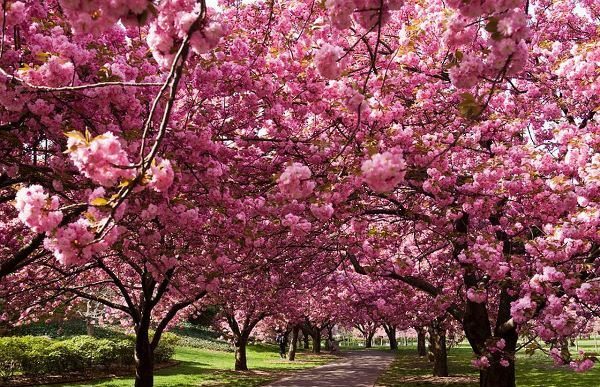
Sakura is not necessary to buy, it reproduces perfectly by cutting. This is much cheaper than buying a sapling. In August, the graft is grafted onto a traditional cherry (or cherry), by budding (eye, kidney).
Decorative fruit tree shapes
The habitual apple tree has a lot of ornamental subspecies that bloom more abundantly than simple apple trees. The blooming scarlet flowers, Ola's apple tree is just flooded with flowers so that you can not see the branches.
- Ola Apple
- Ola apples
Ornamental varieties are grown in the usual agricultural techniques, familiar to gardeners in caring for traditional apple varieties. Fruits - small (heavenly) apples decorate the garden until late autumn. Yellow, red, purple - look great on the branches. They attract birds to the garden; this is a modern version of a natural solution to a pest problem. From heavenly apples is the original jam. Particularly interesting are weeping forms, with a variegated and colored sheet.
Decorative shrubs in landscape design
Shrubs in the garden technically perform the natural function of undergrowth. From an aesthetic point of view - shrubs harmoniously complement garden trees and flower bedsperforming the role of middle managers. This is an extensive class of diverse plants, focus on especially popular species.
Junipers: the type and variety of bushes
Underlined decoration, a wide variety of shapes and varieties,The most common name is given below. Separating phytoncides, junipers substantially purify the air. In sunny weather near the plant soars healing scent. Common plus juniper - cold resistance. Bath lovers will find young juniper twigs that add to the sauna brooms for aroma.
Variegata
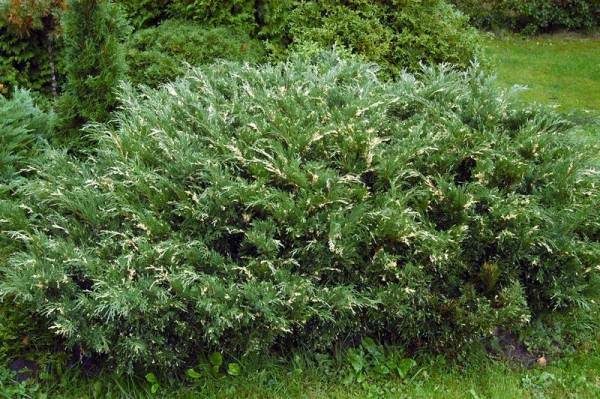
Recognized varieties include Juniper Variegata. Flat, with scaly azure needles, and contrasting sand tassels at the end. The shade is shade tolerant, but in a sunny place the decorative brushes of Variegata will be brighter. An adult plant on a sufficient area will have the appearance of a lush flower bed.
Cossack
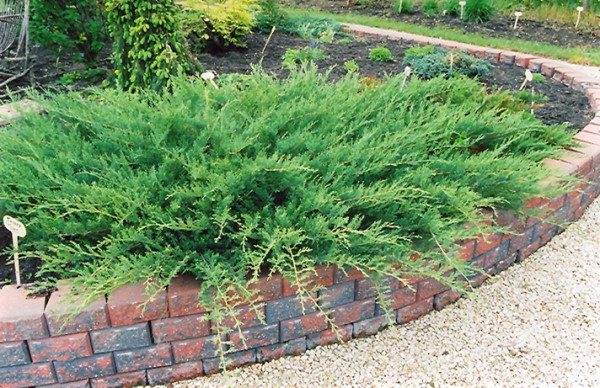
Unpretentious plant smoky color, prefers light soil, looks great in combination with variegated hosts, ordinary and tree peony. Loves loosening and sprinkling of branches.. When transplanting, the pit should be 2 times the root coma. Junipers do not resist pruning, although they do not need mandatory pruning.
Rocky Skye Rocket
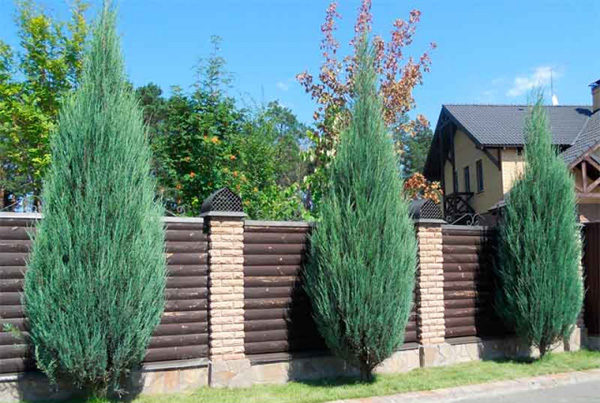
Tall Blue Juniper - Rocky Skye Rocket. In diameter up to 1 meter, in height up to 7 meters. Looks like a slender tree, vaguely reminiscent of cypress.
Glauka
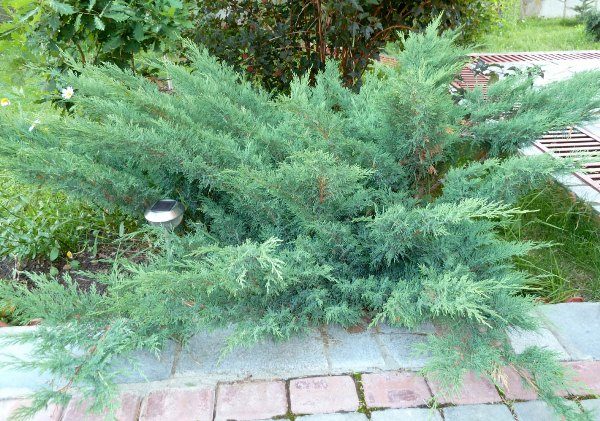
Low Glauka Juniper (up to 30 cm), can grow in width up to 3 meters. The powerful root system of this plant allows, if necessary, to strengthen the slopes. This is a suitable plant for the first plan of the garden composition.
Mint Julit
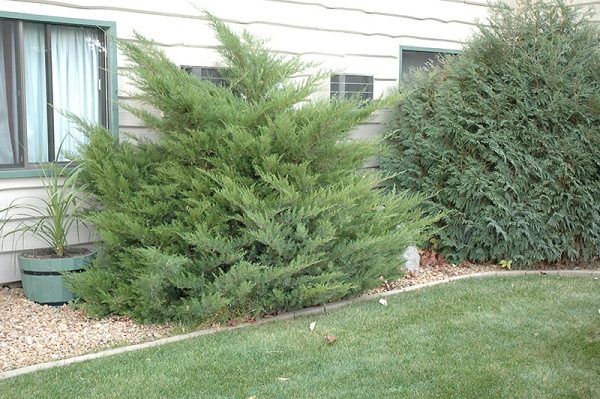
The fastest growing juniper medium - Mint Julit reaches 3.5 m wide to 1.5 m in height. Blue Carpet - active aggressor, occupies a vast space. To pruning reacts enhanced growth. This should be taken into account when planting, and can be used for their own purposes.
Barberry - add bright accents
An interesting shape of the bush, delicate branches, bright foliage inherent in various varieties, allows the barberry to lead among the colored shrubs. Actively blooms in spring. Crown purple, red, mauve, light green in summer, incredibly transformed in the fall. This is a real carnival of colors, from lemon to wine-colored foliage, scarlet clusters of fruit. Barberry berries - excellent seasoning to the pilaf, meat dishes.
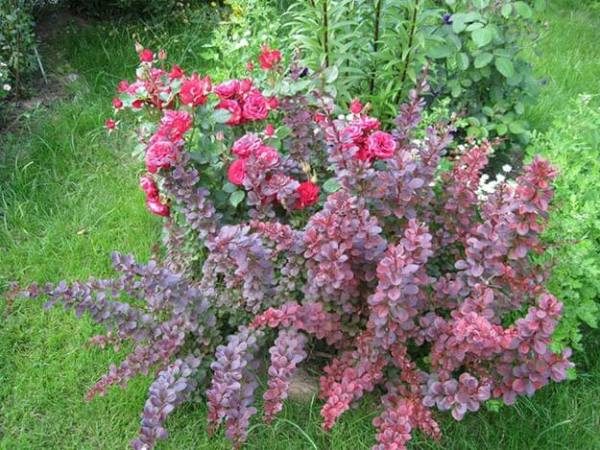
Barberry looks great in single and group plantings. A front garden, an alpine slide, a border around the glades - all these compositions will successfully complement the barberry of the variety and colors that you like. Barberry of different height (from 30 cm to 1.5 m) can be interesting to beat in the mixed mixborder. Barberry Thunberg good in combination with conifers. The undersized pillow shaped barberry Green Carpet is used for Japanese-style rocky compositions.
Barberry it develops well in an open, sunny place, not picky to the soil. Does not tolerate stagnation of groundwater input, when landing the barberry should provide a high-quality drainage pad.
Japanese Quince Henomeles
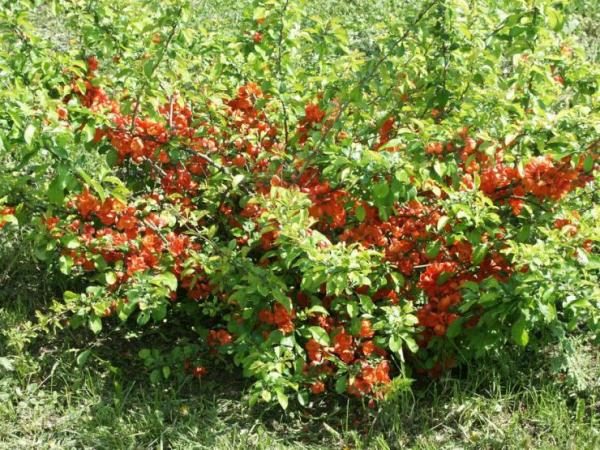
Low shrub (up to 80 cm) inLooks very exotic, richly blooms orange-red flowers. In the summer and in the fall it is decorated with the fruits reminding paradise apples. Used for flowerbeds and rose gardens.
Red viburnum
The habitual bush, does not cease to please with the beauty and useful berries. Kalina is very good in color, in the fall it is colored crimson - yellow, red clusters of berries glow in the sun.
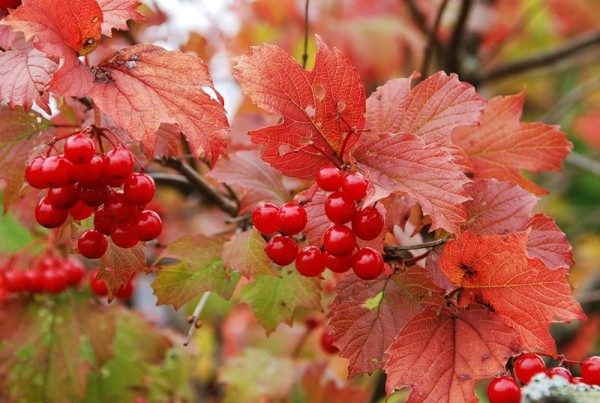
Kalina likes shady places, the bush can grow quite extensively. This property of viburnum can be successfully used to decorate outbuildings, the blank walls of sheds. He likes good watering, the land for planting is mixed with humus (1×1). The land under a bush of viburnum is worth mulching wood bark, it will help the moisture-loving plant to grow.
It grows wild in central and southern Europe, in North Africa, in the European part of Russia, mainly in its middle part and in Asia Minor. Rarely found in the west and north of Russia. Kalina can be found in Central and Western Siberia, as well as in the eastern and northern regions of Kazakhstan. Kalina ordinary does not grow in Central Asia and the Far East.
Garden hydrangea
Familiar for indoor forms, hydrangea Large-leaved garden - a godsend for lovers of bright, actively flowering plants. Large inflorescences (12-15 cm) bloom in July, remain on the branches until autumn. Adult wisteria bush is not high (up to 1 m), can reach two meters in diameter, it needs to be considered when landing. Large inflorescences are white, greenish, crimson, pink and even blue.
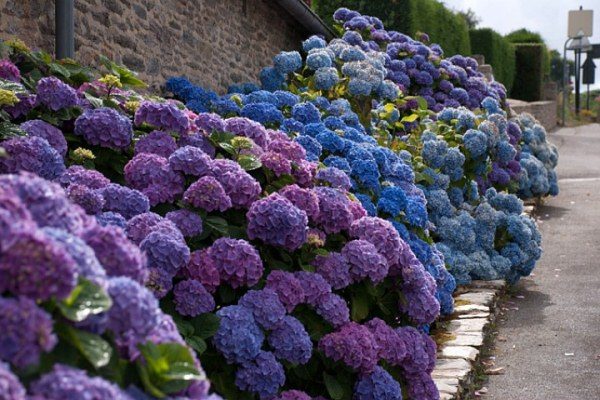
Hortense loves quite lighted places, but direct sunlight is harmful to her. You will need a moist, slightly acidic soil, abundant watering, feeding. When planting in the earthen mixture add peat, sand, coniferous forest land. Feeding up hydrangea with iron preparations, amateurs get bright blue coloring of inflorescences from hydrangea. It is advisable to mulch the stem with needles, use slightly acidified water for irrigation. In winter, hydrangea should be covered.
Interesting new: columnar fruit trees
Compact, productive trees covered with fruits of the usual size, charmed many gardeners. The colonies bear fruit in the second year, they take up little space, it is convenient to take care of them.. The life of such a tree is up to 15 years, unlike the usual longevity of ordinary fruit and stone fruit trees.
What are the columnar trees
Coloniform apple - undersized, dwarf (relatively standard) standard tree. Proven, high-quality varieties - Arbat (red apple of medium maturity), Bolero (winter), Gin (summer variety).
- Colony Apple Arbat
- Colony Apple Tree Bolero
- Columbated apple tree Jin
On sale there are seedlings of columnar trees of the newest selection: plums, cherry plums, pears, peaches. The main problem is the instability of the variety. Dying off of the lower branches, changes in the form of the crown (the formation of a "broom"), freezing of growth buds, rebirth of the variety. There is a frank seller fraud. If you decide to grow colons, buy adapted seedlings in proven regional nurseries.
Features of planting and care for fruit fruit trees
Colons are very comfortable for processing and care, the organization of drip, or point watering. Growing adult fruit tree - about 1.5 m, grown in the usual agricultural techniques, as well as the usual fruit and stone trees. Depending on the variety, seedlings are planted at a distance of 0.4 - 0.7 m from each other. The distance between the rows is 2 - 2.5 m. Seasonal pruning, treatment from pests, top dressing, loosening of the root circle will be required.

After planting a one-year-old sapling, the plant will show its variety in the first year. To do this, leave the tree 2-3 flower ovary, other flowers in the first year is better to remove. The seedling needs strength to adapt to a new place, to form a healthy root system.
Breeding does not stand still, popular varieties are constantly being improved.. Whether it is to experiment with original novelties, or to choose a decorative variety that has been proven over the years, this is the gardener's constant temptation. Based on your taste preferences, you can choose an original decoration for your favorite garden.
